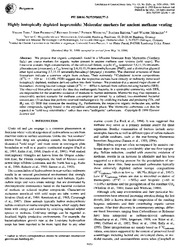Highly isotopically depleted isoprenoids ; molecular markers for ancient methane venting
Zeitschrift: Geochimica et cosmochimica acta, 199963, 23/24: 3959 - 3966
Thiel, Volker; Peckmann, Jörn; Seifert, Richard; Wehrung, Patrick; Reitner, Joachim; Michaelis, Walter, 1999: Highly isotopically depleted isoprenoids ; molecular markers for ancient methane venting. In: Thiel, Volker; Peckmann, Jörn; Seifert, Richard; Wehrung, Patrick; Reitner, Joachim; Michaelis, Walter (1999): Highly isotopically depleted isoprenoids ; molecular markers for ancient methane venting - Geochimica et cosmochimica acta; Vol. 63, 23/24, p. 3959-3966, DOI: 10.23689/fidgeo-2489.
 |
Dokument öffnen: |
We propose that organic compounds found in a Miocene limestone from Marmorito (Northem
Italy) are source markers for organic matter present in aneient methane vent systems (cold seeps). The
limestone contains high concentrations of the tail-to-taillinked, acyclic C20 isoprenoid 2,6,11,15-tetramethylhexadecane
(crocetane), a C25 homolog 2,6,10,15,19-pentamethylicosane (PME), and a distinctive glycerol
ether lipid containing 3,7,1l,15-tetramethylhexadecyl (phytanyl-) moieties. The chemical structures of these
biomarkers indicate a common origin from archaea. Their extreme1y l3C-depleted isotope compositions
(813C "'" -108 to -115.6%0 PDB) suggest that the respective archaea have directly or indirectly introduced
isotopically depleted, methane-derived carbon into their biomass. We postulate that a second major cluster of
biomarkers showing heavier isotope values (8l3C "'" -88%0) is derived from sulfate-redueing bacteria (SRB).
The observed biomarkers sustain the idea that methanogenic bacteria, in a syntrophic community with SRB,
are responsible for the anaerobic oxidation of methane in marine sediments. Marmorito may thus represent a
conceivable aneient scenario for methane consumption performed by a defined, two-membered bacterial
consortium: (1) archaea that perform reversed methanogenesis by oxidizing methane and produeing CO2 and
H2; and (2) SRB that consume the resulting H2. Furthermore, the respective organic molecules are, unlike
other compounds, tightly bound to the crystalline carbonate phase. The Marmorito carbonates can thus be
regarded as "cold seep microbialites" rather than mere "authigenic" carbonates.
Statistik:
ZugriffsstatistikSammlung:
- Geologie [931]

